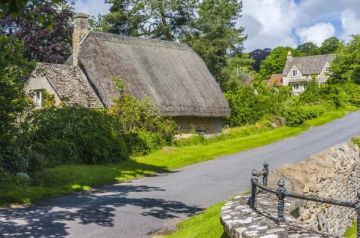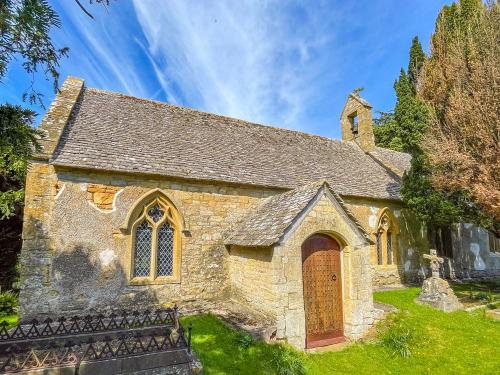
To call Lower Lemington a village is overstating things; it is a rural hamlet, with a cluster of cottages arranged between old barns and the even older parish church of St Leonard. The village was mentioned in the Domesday Book, when 15 residents were recorded. The current population must be close to the same number.
Historical Highlights
- 12th-century doorways and chancel arch
- 17th-century queen-post roof
- 18th-century wooden pulpit with candle holders
- Norman tub font in chancel
- Medieval parish chest
- Memorial brass, 1636
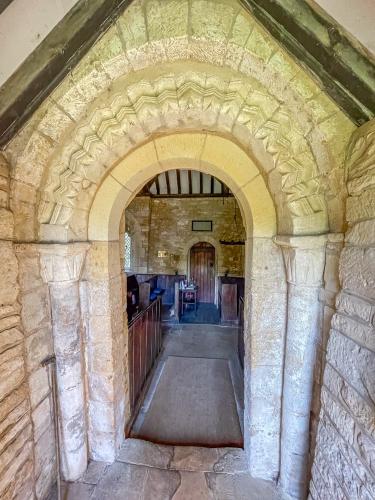
History
We know that there was a church in Lower Lemington by the 11th-century, and the narrow, round-headed chancel arch may be a survivor from this Saxon building. By the 12th century Lower Lemington was a chapel connected to Tewkesbury Abbey. It does not appear to have had its own vicar during the Middle Ages, being served by a curate until the 17th century.
An Angry Curate
In 1642 a man named John Smith was named as the curate of Lower Lemington. A report from 1655 tells us that Smith was deemed 'notoriously scandalous being a swearer, a drunkard, and a fighter,' and he was deprived of his living. In 1660 Smith attacked the new curate during a sermon and forcibly removed him from the church. In 1661 no minister was listed in church records.
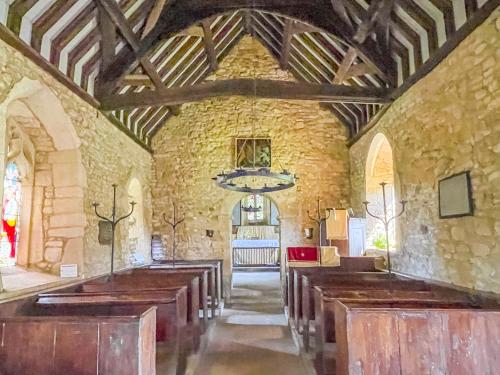
St Leonard's Church is set in an idyllic location, looking over fields. The building plan is very simple, and the layout may be that of the original Saxon church. It is composed of a nave, chancel, south porch, and north vestry, with a single bellcote over the chancel arch.
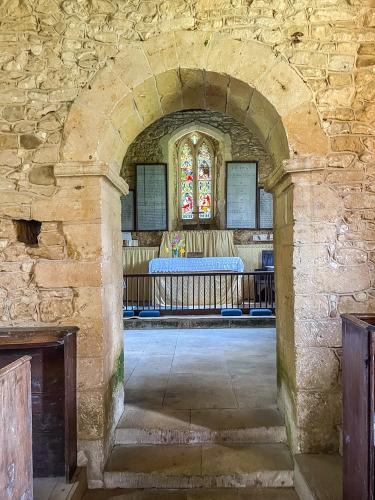
A Saxon Arch?
The chancel arch is only 4 feet wide and rises 6 feet to the arch spring (the place where the columns that support the arch stop and the curved head of the arch begins). To either side of the chancel arch is an opening, probably a rough squint, allowing views of the altar.
The south doorway may be slightly older than the chancel arch, probably dating to the 12th century. The doorway arch is decorated with traditional chevron patterns and is supported by columns with scalloped capitals. Opposite is a north doorway of the same period, though without any carved decoration.
Interestingly, records show that the church was given money for a tower in a bequest dated 1513, but the money was never accessed and the tower was never built.
The nave roof dates to the 14th century and over the chancel arch is a royal coat of arms to George III, erected in 1815 to celebrate victory over Napoleon following the Battle of Waterloo.
Civil War Damage
The chancel was damaged in the Civil War, and much of what we see in the chancel today dates from a late 17th-century rebuilding. The church was damaged by cannonballs during the war and there is supposed to be a mass grave in the churchyard thought to be burials from this conflict. I say 'supposed to be' because we couldn't find any evidence of the burial in a search of the burial ground, but it may not have been marked by a memorial stone.
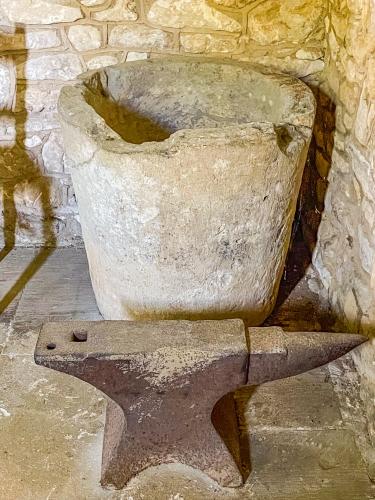
The most interesting historical feature inside the church is a roughly-cut Norman font in tub style, stored inside the chancel. It was lost for many years until it was discovered being used as a water trough for animals and was returned to the church.
Curiously, an old anvil sits on the floor next to the font, but the church guide provides no information on what an anvil is doing in the church! The medieval font is no longer in use, and a very plain modern font stands in the south-west corner of the church.
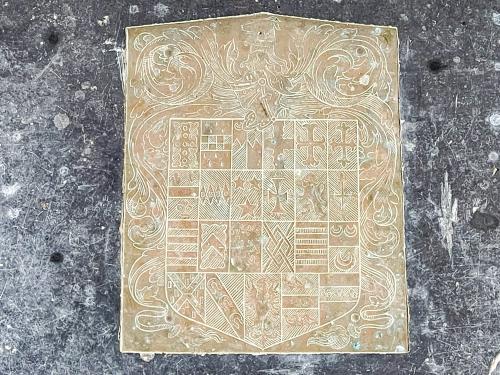
The Greville Brass
In the chancel is a wooden chair made from 15th-century benches, and set into the floor in front of the communion table is a memorial brass to two 17th-century brothers.
The epitaph (complete with original spelling) reads:
'Here lye the bodies of Charles Grevill [Greville] and Peter Grevill Esquiors whoe were natural brethren and late patrones of this chappell. They were brought up and lived together in a vertuous & pious course and taking true content and comfort one in the other ledd single lives and died batchellors. Anno Dni. 1636.'
Charles and Peter Greville lived at Upper Lemington Manor. Their father, Ludovic Greville of Sezincote, was accused of murder and died under torture in 1589.
Ludovic Greville wanted lands owned by Richard Webb, so he forged Webb's will, making him the heir, and then had Webb killed. Unfortunately for Greville, one of his accomplices got drunk and bragged of the deed, and Greville was arrested. He refused to admit the crime so that the lands would not be seized by the Crown, and was executed by being pressed to death.
Charles Greville died in 1628 and Peter at an unknown date. The brass was installed by their cousin, Lord Brooke, in 1636.
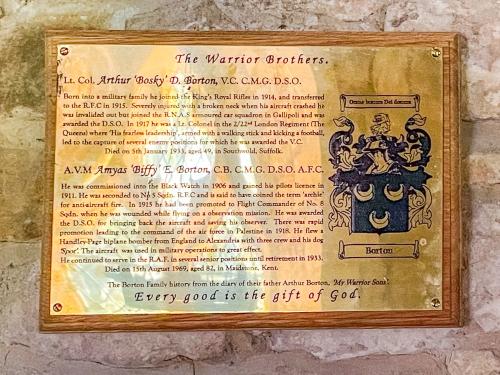
On the nave wall are two brass plaques. One commemorates 'The Warrior Brothers', Lt. Col. Arthur 'Bosky' Borton, and AVM Amyas 'Biffy' Borton, who both fought with distinction in WWI. The second plaque was erected in honour of 2nd Lieutenant William Lidsey, baptised in this church, who on two occasions flew against the 'Red Baron'.
The Borton plaque reads:
Lt. Col. Arthur 'Bosky' D. Borton, V.C. C.M.G. D.S.O.
Born into a military family he joined the King's Royal Rifles in 1914, and transferred to the R.F.C. in 1915. Severely injured with a broken neck when his aircraft crashed he was invalided out but joined the R.N.A.S armoured car squadron in Gallipoli and was awarded the D.S.O. In 1917 he was a Lt. Colonel in the 2/22nd London Regiment (The Queens) where his 'fearless leadership', armed with a walking stick and kicking a football, led to the capture of several enemy positions for which he was awarded the V.C. Died on 5th January 1933, aged 49, in Southwold, Suffolk.
A.V.M. Amyas 'Biffy' E. Borton, C.B. C.M.G. D.S.O. A.F.C.
He was commissioned into the Black Watch in 1906 and gained his pilot's licence in 1911. He was seconded to No 5 Sqdn. R.F.C and is said to have coined the term 'archie' for anti-aircraft fire. In 1915 he had been promoted to Flight Commander of No. 8 Sqdn. when he was wounded while flying on a observation mission. He was awarded the D.S.O. for bringing back the aircraft and saving his observer. There was rapid promotion leading to command of te air force in Palestine in 1918. He flew a Handley-Page biplane bomber from England to Alexandria with three crew and his dog 'Spot'. The aircraft was used in military operations to great effect.
He continued to serve in the R.A.F. in several senior positions until retirement in 1933. Died on 15th August 1969, aged 82, in Maidstone, Kent.
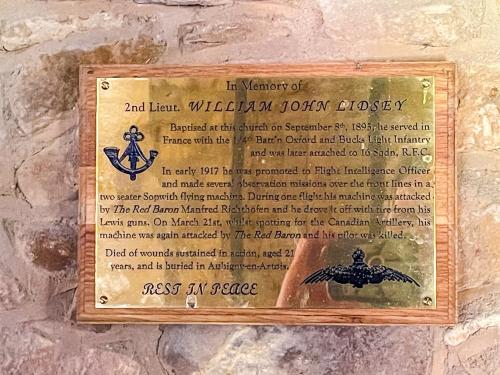
The Lidsey plaque offers a fascinating insight into WWI air combat and reads:
In Memory of 2nd Lieut. William John Lidsey
Baptised in this church on September 8th, 1895, he served in France with the 1/4th Battalion Oxford and Bucks Light Infantry and was later attached to 16 Sqdn. R.F.C.
In early 1917 he was promoted to Flight Intelligence officer and made several observation missions over the front lines in a two seater Sopwith flying machine. During one flight his machine was attacked by The Red Baron Manfred Richtofen and he drove it off with fire from his Lewis guns. On March 21st, whilst spotting for the Canadian Artillery, his machine was again attacked by The Red Baron and his pilot was killed.
Died of wounds sustained in action, aged 21 years, and is buried in Aubigny-en-Artois. Rest in Peace.

Visiting
St Leonard's Church is a delight, and the rural setting is wonderful. You feel like you're a million miles from anywhere, and a sense of timelessness clings to the church.
Lower Lemington is at the end of a country lane, just off the A429 (Fosse Way) north of Moreton-in-Marsh. There is parking for several cars behind the barn at the end of the lane. The church is open daily to visitors and was open when we visited.
About Lower Lemington, St Leonard's Church
Address: Lower Lemington,
Cotswolds,
Gloucestershire,
England, GL56 9NR
Attraction Type: Historic Church
Location: On a country lane off the A429, just north of Moreton-in-Marsh
Website: Lower Lemington, St Leonard's Church
Location
map
OS: SP218345
Photo Credit: David Ross and Britain Express
HERITAGE
 We've 'tagged' this attraction information to help you find related historic attractions and learn more about major time periods mentioned.
We've 'tagged' this attraction information to help you find related historic attractions and learn more about major time periods mentioned.
Historic Time Periods:
Find other attractions tagged with:
11th century (Time Period) - 12th century (Time Period) - 17th century (Time Period) - 18th century (Time Period) - Norman (Architecture) - Saxon (Time Period) -
NEARBY HISTORIC ATTRACTIONS
Heritage Rated from 1- 5 (low to exceptional) on historic interest
Four Shire Stone - 1.6 miles (Historic Building) ![]()
Todenham, St Thomas of Canterbury Church - 1.9 miles (Historic Church) ![]()
Great Wolford, St Michael's Church - 1.9 miles (Historic Church) ![]()
Batsford, St Mary's Church - 2 miles (Historic Church) ![]()
Batsford Arboretum - 2 miles (Garden) ![]()
Stretton-on-Fosse, St Peter's Church - 2.4 miles (Historic Church) ![]()
Barton-on-the-Heath, St Lawrence Church - 2.6 miles (Historic Church) ![]()
Bourton House Garden - 2.9 miles (Garden) ![]()
Nearest Holiday Cottages to Lower Lemington, St Leonard's Church:
Moreton-in-Marsh, Gloucestershire
Sleeps: 6
Stay from: £669 - 2816
Chipping Campden, Gloucestershire
Sleeps: 4
Stay from: £538 - 1827
Moreton-in-Marsh, Gloucestershire
Sleeps: 5
Stay from: £511 - 2113
More self catering near Lower Lemington, St Leonard's Church











